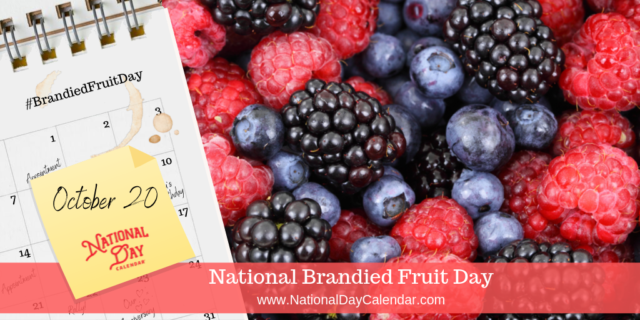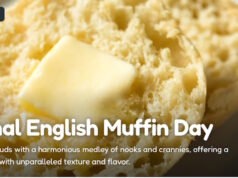
On October 20 each year, we celebrate the delicious food holiday known as National Brandied Fruit Day!
- Brandied fruit first became popular around the Victorian era. During this time, it was discovered by adding brandy to fruit, it was easiest way to make it last longer. Incidentally, this process was also a great way to harvest the taste of fruit, while creating a delicious dessert for adults.
- Interestingly, brandied fruit is used as a starter for Friendship Cake. Similar to the concept of a starter for sourdough bread, Friendship Cake takes time to prepare.
- Brandied fruit is used as topping on pies and ice cream.
- Brandy is distilled from fruits such as grape, apple, blackberry, apricot and so on.
- Based on the region and the fruit, brandy can be divided into several categories: Cognac, Armagnac, American Brandies, and fruit brandies.
- The word brandy originally comes from the Dutch word brandewijn, which means burnt wine.
- Long before the 16th century, wine was a popular product for trading in European region. In the early 16th century, a Dutchman trader invented the way to ship more wine in the limited cargo space by removing water from the wine. Then he could add the water back to the concentrated wine at the destination port in Holland.
- They called it “bradwijn,” meaning “burned wine,” and later became “brandy.”
- Most brandy is 80 proof (40% alcohol/volume) and has been enjoyed for centuries as a cocktail and cooking ingredient.
- Cognac and Armagnac are both French brandies made from white wine grapes.
- American brandies are mostly distilled in California where the grape grows. According to the U.S. law, American brandies must be aged for at least 2 years in wood.
- Brandy has a traditional age grading system, although its use is unregulated outside of Cognac and Armagnac. These indicators can usually be found on the label near the brand name: VS, VSOP, XO, and Hors d’âge.
- VS stands for “Very Special”: only eaux-de-vie at least two years old can be used to make a VS cognac. Other denominators and expressions are permitted, such as “3 stars” or “luxury”, and as such are included in the VS cognac category.
- VSOP stands for “Very Superior Old Pale”: VSOP cognacs are created from eaux-de-vie aged for at least four years. The VSOP category includes designations such as “Old” or “Reserve”.
- XO stands for “Extra Old”: XO cognacs are made only from eaux-de-vie at least six years old. Cognacs such as “Napoleon” or “Old Reserve” are equivalent to XO cognac.
- Hors d’âge (literally meaning Beyond Age) is a designation which BNIC states is equal to XO, but in practice the term is used by producers to market a high-quality product beyond the official age scale.
- Brandy has many health benefits such as increase the strength of the immune system, reduces respiratory issues, control weight issues, improve your sleep patterns, treatment for pneumonia, boost heart health, treat certain types of cancer and it has ability to slow the signs of aging.
- During ageing, evaporation contributes to the progressive reduction of the alcohol level. It varies with storage conditions, but averages 2% per year. This is called “The angels’ share.”
- Some of the earliest thermometers—used in the 1600s—contained brandy instead of mercury. The liquor was eventually replaced with mercury due to the latter material’s wider range of liquid-state temperature.
- The largest collection of brandy is 1057 bottles, achieved by Manuel Bru Vicente (Spain), in Elche, Alicante, Spain, as confirmed on 1 January 2017.
Sources:












